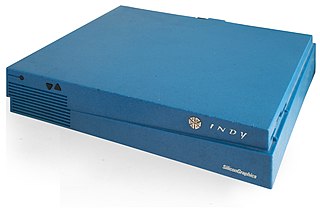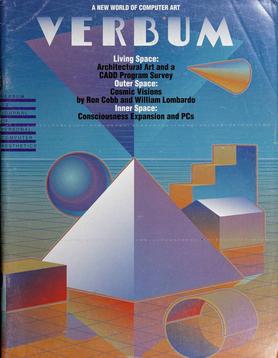Desktop publishing (DTP) is the creation of documents using page layout software on a personal ("desktop") computer. It was first used almost exclusively for print publications, but now it also assists in the creation of various forms of online content. Desktop publishing software can generate layouts and produce typographic-quality text and images comparable to traditional typography and printing. Desktop publishing is also the main reference for digital typography. This technology allows individuals, businesses, and other organizations to self-publish a wide variety of content, from menus to magazines to books, without the expense of commercial printing.

Aldus Corporation was an American software company best known for its pioneering desktop publishing software. PageMaker, the company's most well-known product, ushered in the modern era of desktop computers such as the Macintosh seeing widespread use in the publishing industry. Paul Brainerd, the company's co-founder, coined the term desktop publishing to describe this paradigm. The company also originated the Tag Image File Format (TIFF) file format, widely used in the digital graphics profession.

The ImageWriter is a product line of dot matrix printers formerly manufactured by Apple Computer, Inc., and designed then to be compatible with their entire line of computers. There were three different models introduced over time, which were popular mostly among Apple II and Macintosh owners.

System 6 is a graphical user interface-based operating system for Macintosh computers, made by Apple Computer It was released in 1988, and is part of the classic Mac OS series. It is a monolithic operating system, with cooperative multitasking based on an improved MultiFinder. The boxed version cost US$49, and it was included with all new Macintosh computers until 1991, when it was succeeded by System 7.
Lingo is a verbose object-oriented (OO) scripting language developed by John H. Thompson for use in Adobe Director. Lingo is used to develop desktop application software, interactive kiosks, CD-ROMs and Adobe Shockwave content.

The Apple Macintosh—later rebranded as the Macintosh 128K—is the original Apple Macintosh personal computer. It played a pivotal role in establishing desktop publishing as a general office function. The motherboard, a 9 in (23 cm) CRT monitor, and a floppy drive were housed in a beige case with integrated carrying handle; it came with a keyboard and single-button mouse. It sold for US$2,495. The Macintosh was introduced by a television commercial entitled "1984" shown during Super Bowl XVIII on January 22, 1984 and directed by Ridley Scott. Sales of the Macintosh were strong at its initial release on January 24, 1984, and reached 70,000 units on May 3, 1984. Upon the release of its successor, the Macintosh 512K, it was rebranded as the Macintosh 128K. The computer's model number was M0001.

The Indy, code-named "Guinness", is a low-end multimedia workstation introduced on July 12, 1993. Silicon Graphics Incorporated (SGI) developed, manufactured, and marketed Indy as the lowest end of its product line, for computer-aided design (CAD), desktop publishing, and multimedia markets. It competed with Intel x86 computers, and with Windows and Macintosh, including using their files and running their applications via software emulation. It is the first computer to come standard with a video camera, called IndyCam. Indy was repackaged as a server model called Challenge S. Indy was discontinued on June 30, 1997 and support ended on December 31, 2011.

Adobe Shockwave is a discontinued multimedia platform for building interactive multimedia applications and video games. Developers originate content using Adobe Director and publish it on the Internet. Such content could be viewed in a web browser on any computer with the Shockwave Player plug-in installed. MacroMind originated the technology; Macromedia acquired MacroMind and developed it further, releasing Shockwave Player in 1995. Adobe then acquired Shockwave with Macromedia in 2005. Shockwave supports raster graphics, basic vector graphics, 3D graphics, audio, and an embedded scripting language called Lingo.
A Rich Internet Application is a web application that has many of the characteristics of desktop application software. The concept is closely related to a single-page application, and may allow the user interactive features such as drag and drop, background menu, WYSIWYG editing, etc. The concept was first introduced in 2002 by Macromedia to describe Macromedia Flash MX product. Throughout the 2000-s, the term was generalized to describe browser-based applications developed with other competing browser plugin technologies including Java applets, Microsoft Silverlight.
mTropolis was an open-architecture multimedia programming application aimed at enabling rapid development of multimedia titles. It was developed by mFactory and introduced in 1995. It introduced object-oriented concepts such as reusable objects, modifiers and behaviors into the multimedia authoring space dominated by Macromedia's Director software. mTropolis was bought in 1997 by Quark, which moved development from Burlingame, California to Denver and then cancelled the product one year later. Despite efforts by its fervent users to attempt to save their investment and beloved tool, negotiations and even a possible purchase offer never came to fruition.
Mac gaming refers to the use of video games on Macintosh personal computers. In the 1990s, Apple computers did not attract the same level of video game development as Microsoft Windows computers due to the high popularity of Microsoft Windows and, for 3D gaming, Microsoft's DirectX technology. In recent years, the introduction of Mac OS X and support for Intel processors has eased porting of many games, including 3D games through use of OpenGL and more recently Apple's own Metal API. Virtualization technology and Boot Camp also permit the use of Windows and its games on Macintosh computers. Today, a growing number of popular games run natively on macOS, though as of early 2019, a majority still require the use of Microsoft Windows.

Microsoft Bookshelf is a discontinued reference collection introduced in 1987 as part of Microsoft's extensive work in promoting CD-ROM technology as a distribution medium for electronic publishing. The original MS-DOS version showcased the massive storage capacity of CD-ROM technology, and was accessed while the user was using one of 13 different word processor programs that Bookshelf supported. Subsequent versions were produced for Windows and became a commercial success as part of the Microsoft Home brand. It was often bundled with personal computers as a cheaper alternative to the Encarta Suite. The Encarta Deluxe Suite / Reference Library versions also bundled Bookshelf.

Adobe Director was a multimedia application authoring platform created by Macromedia and managed by Adobe Systems until its discontinuation.

The Apple AudioVision 14 Display is a 14-inch Trinitron display that was manufactured by Apple Computer Inc.
MacPublisher was the first Desktop Publishing program for the Apple Macintosh, introduced in 1984, the same year that Apple introduced the Macintosh. DTP competitors Ready, Set, Go! and Aldus PageMaker were introduced in 1985 when Apple delivered the 512K Macintosh.
Desktop Publishing magazine was founded, edited, and published by Tony Bove and Cheryl Rhodes of TUG/User Publications, Inc., of Redwood City, California.). Its first issue appeared in October 1985, and was created and produced on a personal computer with desktop publishing software, preparing output on a prototype PostScript-driven typesetting machine from Mergenthaler Linotype Company. Erik Sandberg-Diment, a columnist at The New York Times, tried to buy the venture outright when he saw an early edition.

Verbum was an early personal computer and computer art magazine focusing on interactive art and computer graphics. It was edited and published from 1986 until 1991 by Michael Gosney. It, along with Info 64, was one of the first periodicals to be entirely based on desktop publishing techniques. Referring to itself as a "journal of personal computer aesthetics," Verbum was notable for placing more emphasis on creative aspects of its subject matter in contrast to the overwhelmingly technical content of other publications.

Adobe Shockwave Player is a discontinued freeware software plug-in for viewing multimedia and video games created on the Adobe Shockwave platform in web pages. Content was developed with Adobe Director and published on the Internet. Such content could be viewed in a web browser on any computer with the Shockwave Player plug-in installed. It was first developed by Macromedia and released in 1995; it was later acquired by Adobe Systems in 2005.

The power key, or power button, is a key found on many computer keyboards during the 1980s and into the early 2000s. They were introduced on the first Apple Desktop Bus keyboards in the 1980s and have been a standard feature of many Macintosh keyboards since then. They are also found on an increasing number of Microsoft Windows keyboards, sometimes supplanted with additional keys for sleep. The power key is becoming increasingly rare, as most modern personal computers using USB allow the system to be started up by pressing any key on the keyboard.












